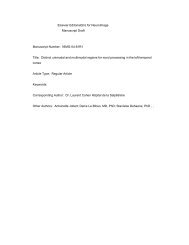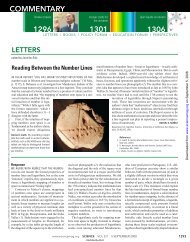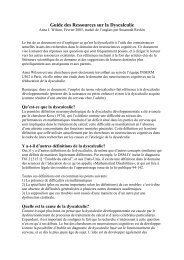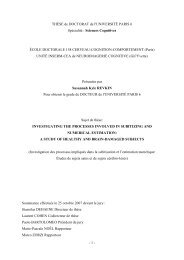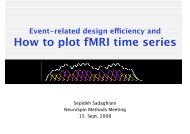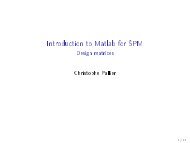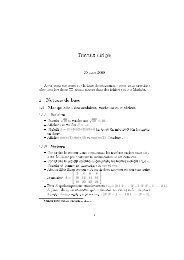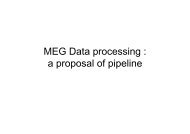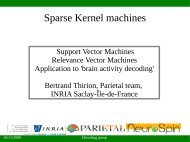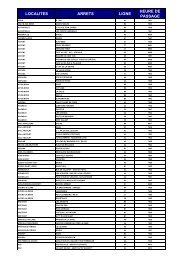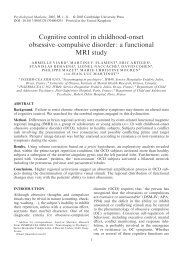Analisi multidimensionale della dinamica neurale di un processo ...
Analisi multidimensionale della dinamica neurale di un processo ...
Analisi multidimensionale della dinamica neurale di un processo ...
Create successful ePaper yourself
Turn your PDF publications into a flip-book with our unique Google optimized e-Paper software.
sciente <strong>di</strong> <strong>un</strong>o o dell’altro stimolo, nonostante che le proprietà fisiche <strong>della</strong> stimolazione<br />
binoculare rimanessero costanti; Fujiki et al. [2002] hanno <strong>di</strong>ssociato l’elaborazione<br />
del segnale proveniente da ogni singolo orecchio stimolando simultaneamente<br />
i due orecchi con frequenze leggermente <strong>di</strong>verse e seguendo l’attività cerebrale<br />
risonante a quelle frequenze. L’idea alla base del metodo frequency-tagging<br />
può essere generalizzata ipotizzando che la struttura temporale dell’attività <strong>di</strong> <strong>un</strong>a<br />
specifica popolazione <strong>neurale</strong> rifletta quella degli stimoli che quella popolazione<br />
co<strong>di</strong>fica. Evidenze <strong>di</strong> questo meccanismo sono emerse nel campo <strong>della</strong> percezione<br />
sensoriale [Schroeder e Lakatos, 2008] e dell’elaborazione <strong>di</strong> <strong>un</strong> <strong>di</strong>scorso [Luo e<br />
Poeppel, 2007].<br />
7. Conclusioni<br />
Grazie alla loro ottima risoluzione temporale ed estensione spaziale, l’EEG e<br />
la MEG permettono <strong>di</strong> tracciare l’evoluzione spazio-temporale dell’attività <strong>neurale</strong><br />
associata a <strong>un</strong> qualsiasi <strong>processo</strong> cognitivo. In questo capitolo abbiamo visto che<br />
possono essere stu<strong>di</strong>ati contemporaneamente aspetti <strong>di</strong>versi e in buona parte complementari<br />
<strong>di</strong> questa risposta esplorando i segnali MEEG l<strong>un</strong>go <strong>di</strong>verse ‘<strong>di</strong>mensioni’:<br />
tempo, frequenza, correlazione spaziale (interazione tra canali), correlazione<br />
con la struttura temporale dello stimolo.<br />
I meto<strong>di</strong> descritti sono solo <strong>un</strong>a minima parte <strong>di</strong> quelli proposti in letteratura.<br />
Speriamo com<strong>un</strong>que <strong>di</strong> aver dato <strong>un</strong>’idea <strong>della</strong> ricchezza <strong>di</strong> informazioni che<br />
possono essere dedotte dai segnali MEEG, e conseguentemente <strong>della</strong> potenzialità<br />
dell’EEG e <strong>della</strong> MEG nell’investigare le basi neurali delle f<strong>un</strong>zioni cognitive. Numerosi<br />
altri aspetti dell’attività <strong>neurale</strong> che possono essere descritti da dati MEEG<br />
(ad esempio, ricostruzione delle sorgenti, causalità delle interazioni tra regioni cerebrali<br />
<strong>di</strong>verse, pattern <strong>di</strong> connettività) sono affrontati in profon<strong>di</strong>tà negli altri capitoli<br />
<strong>di</strong> questo volume.<br />
Bibliografia<br />
Berger, H. (1929), On the EEG in humans. Arch. Psychiatr. Nervenkr. 87: 527-<br />
570.<br />
Buiatti M. et al., in preparation.<br />
Buiatti M. (2007), Internal Report, CIMeC, University of Trento.<br />
Buiatti M. (2008), The Correlated Nature of Large-scale Neural Activity Unveiled<br />
by the Resting Brain. Riv Biol-Biol Forum 101: 353-373.<br />
Buiatti M., Papo D., Baudonnière P.-M., van Vreeswijk C. (2007), Feedback<br />
modulates the temporal scale-free dynamics of brain electrical activity in a<br />
hypothesis testing task. Neuroscience 146: 1400-1412.<br />
Buiatti M., Peña M., Dehaene-Lambertz G. (2009), Investigating the neural<br />
correlates of continuous speech computation with frequency-tagged neuroelectric<br />
responses. NeuroImage 44: 509-519.<br />
Caplan J.B., Madsen J.R., Schulze-Bonhage A., Aschenbrenner-Scheibe R.,<br />
16



